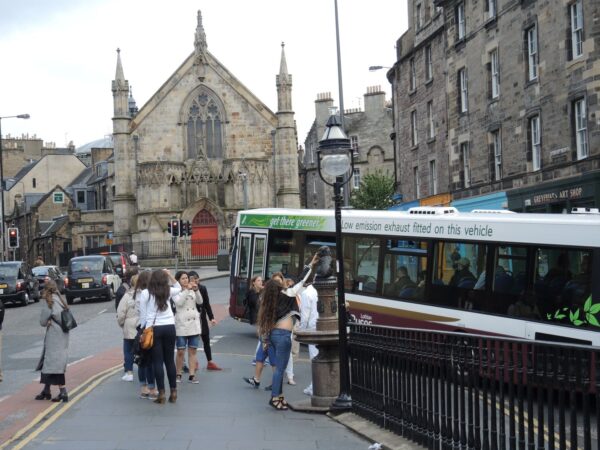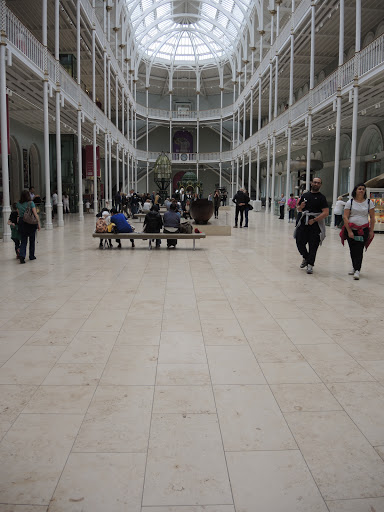When I reached the hotel Thursday night, I was uncertain whether I’d return to St. Andrews for Friday’s play. Because of the notorious unpredictability of Scotland’s weather, I’d purchased tickets for the first two days hoping one of them would be reasonable for watching golf. I’d seen my day of play, walked the course, and was, frankly, a bit tired from the five-hour time change and all the running around.
Those of you who followed the tournament know that the weather wreaked some havoc with the play. For those who don’t know, Thursday night so much severe rain poured down on St. Andrews that it rendered the Old Course unplayable in the morning thereby delaying the morning starts for several hours. Some players had to finish their second round on Saturday – a day when the winds were so severe and play so limited that it forced the first Monday finish since 1988.
I decided to stay in Edinburgh. This had one minor golf-related consequence. The threesome that featured Tom Watson – a group I thought would have to finish play on Saturday – played until after 22:00 and finished their round.
The 65-year-old Watson, who had been granted a special exemption to play (former Open champions are generally exempt to age 60) was making his final appearance as a player at the Open. Those who watched him cross Swilcan Bridge for the final time might have noticed that the grandstand at the 18th green was virtually empty. The crowd along the road was large for the space but certainly manageable. Had I gone and had the train schedule allowed me to stay, I could have could have been among the few to have seen that moment live – something I’d liked to have done.
Instead, convinced that Watson wouldn’t finish Friday, I chose a relaxed day in Edinburgh. I spent much of the morning in my hotel room sorting pictures and beginning to draft the record of my travels. In the afternoon, I went out for a bite to eat and decided to visit the Scottish National Museum – a short walk from the hotel.
On my way, I snapped a photo of people rubbing the nose of the statue of Grayfriars Bobby that I mentioned in an earlier post.

Living near Washington, D.C., I’m accustomed to the Smithsonian Institution and its vast array of individual museums so I always experience a small jolt when I enter a single museum that combines elements of history, technology, culture, natural history, and the like as this one does.
The entry to the museum is on the ground floor and the dark closeness of it doesn’t quite prepare you for the light filled grand atrium above
There are, in fact, two museums in the complex. The one in the above photo is the eclectic National Museum. At the far end of the picture a hallway connects to another museum that covers expanse of Scottish history.
The principal exhibition (currently) in the National Museum is called World Cultures. It’s a fascinating tour of indigenous cultures that presents not only how one specific culture has shaped its environment but how the environment has shaped the culture. The herding people of the Tibetan plateau, Pacific Islanders, Aboriginal Australians, Native Americans, and Inuit peoples of the Arctic are just some of the cultures represented in the exhibition.
My jolt happened when I passed from that exhibition into an adjoining gallery focused on natural history. I found this a bit odd not only because of its proximity to the World Cultures exhibit but also by the juxtaposition of extinct animals with non-extinct ones such as a giraffe and saber-toothed tiger (which I’m not certain ever shared geographic proximity).
This flowed to an exhibit of earth in space and, exiting that, I passed into an exhibition of paintings and artifacts dealing with the battle of Waterloo. Another seeming incongruity was the interesting though small display of Japanese porcelains.
My visit to the History Museum proved more educational than the National Museum itself mainly because I know so little about Scottish history. The first thing I noticed entering the main exhibition was that both the wall to my right and the wall to my left had passages from the Letter or Declaration of Arbroath.
This, I learned was written in 1320 and on 6 April of that year was sent as a letter in Latin to Pope John XXII as one part of a political campaign to assert that Scotland was an independent Kingdom and not subject to the rule of England’s Norman Kings. The document also sought to have the Pope’s excommunication of Robert Bruce lifted.
After he murdered John Comyn, the Guardian of Scotland for Edward I, whom the Pope had earlier recognized as the legitimate ruler of Scotland, Bruce had been excommunicated by John XXII.
Recall that the rebellion led by William Wallace, who died 14 years earlier was to overthrow King John De Balliol who was seen as Edward’s puppet and that Wallace and Andrew de Moray would install Bruce as King Robert the First. Perhaps as a justification for this, the Declaration asserted the idea that a king ruled by consent of his subjects and not necessarily by divine right.
The Declaration asserted that Edward I,
“had unjustly attacked Scotland and perpetrated atrocities; that Robert the Bruce had delivered the Scottish nation from this peril; and, that the independence of Scotland was the prerogative of the Scottish people, rather than the King of Scots.”
Anyone think Thomas Jefferson and his fellow founders were familiar with this document when they drafted this one?
The passage on one wall reads,
“as long as but a hundred of us remain alive, never will we on any conditions be brought under English rule.”
And on the other,
“For we fight not for glory, nor riches, nor honours that we are fighting, but for freedom – for that alone, which no honest man gives up but with life itself.”
Since this is intended to be a travel blog and not a history text, I’ll end the lesson here. Those of you who are so motivated can proceed on your own.
After a nice Italian dinner at Vittoria on the Bridge, I returned to the hotel, did some additional writing and photo sorting and watched the last threesomes of the day at St. Andrews. As I noted above, I grew increasingly frustrated as it became clear that the course officials were going to allow Tom Watson to finish his round even if it meant dislodging streetlights and repositioning them around the 18th green. With it all, Watson handled his final crossing of Swilican Bridge with class and grace.
Saturday was a travel day on which I spent an inordinate amount of time at the airport because my flight’s departure was delayed by nearly two hours due to “mechanical reasons.” Add that to the “arrive two hours prior to your flight” directive and the inevitable outcome is a long day at the airport. My arrival in Copenhagen came so late that I missed the pre-tour orientation and barely made dinner although some fellow travelers later informed me that my late arrival made for a memorable introduction to the group.
The highlights of the day were my lunch – consisting of my first bowl of Cullen Skink, a creamy soup with haddock (those familiar with Cole Porter should know that the most authentic Cullen Skink will use finnan haddie), potatoes, and onions to which I added a plate of Arbroath smokies(a special smoked herring from that small fishing village)

– and flipping on the computer when I got to my room and finding an email from my brilliant Jinja (sound it out as the Australian variant of ginger). We’d adopted one another as a sort of father and daughter on the Mongolian Express trip two years ago. Tomorrow I will explore the Capital of Denmark beginning with a three-hour (bus) tour.
